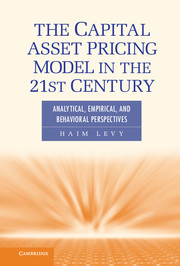 The Capital Asset Pricing Model in the 21st Century
The Capital Asset Pricing Model in the 21st Century Book contents
- Frontmatter
- Contents
- Preface
- 1 Introduction
- 2 Expected Utility Theory
- 3 Expected Utility and Investment Decision Rules
- 4 The Mean-Variance Rule (M-V Rule)
- 5 The Capital Asset Pricing Model
- 6 Extensions of the Capital Asset Pricing Model
- 7 The Capital Asset Pricing Model Cannot Be Rejected
- 8 Theoretical and Empirical Criticism of the Mean-Variance Rule
- 9 Prospect Theory and Expected Utility
- 10 Cumulative Decision Weights
- 11 The Mean-Variance Rule, the Capital Asset Pricing Model, and the Cumulative Prospect Theory
- References
- Name Index
- Subject Index
8 - Theoretical and Empirical Criticism of the Mean-Variance Rule
Published online by Cambridge University Press: 05 June 2012
- Frontmatter
- Contents
- Preface
- 1 Introduction
- 2 Expected Utility Theory
- 3 Expected Utility and Investment Decision Rules
- 4 The Mean-Variance Rule (M-V Rule)
- 5 The Capital Asset Pricing Model
- 6 Extensions of the Capital Asset Pricing Model
- 7 The Capital Asset Pricing Model Cannot Be Rejected
- 8 Theoretical and Empirical Criticism of the Mean-Variance Rule
- 9 Prospect Theory and Expected Utility
- 10 Cumulative Decision Weights
- 11 The Mean-Variance Rule, the Capital Asset Pricing Model, and the Cumulative Prospect Theory
- References
- Name Index
- Subject Index
Summary
Introduction
We have seen in Chapter 4 that the Mean-Variance (M-V) rule can justifiably be employed under investment decision settings, in three distinct cases: 1) when the utility function is quadratic, 2) when distributions of return are normal in the face of risk aversion, and 3) when the variance of rates of return is not too large. The assumption under quadratic preferences is generally not accepted because this function has some well-known drawbacks, which have been discussed in detail in Chapter 4. Employing the M-V rule as an approximation to expected utility, although generally providing an excellent approximation, may raise some objections because the quality of the approximation depends on the data set involved: it may provide an excellent fit in one case and not such a good fit in another case. Therefore, the most compelling theoretical argument for the employment of the M-V rule is the case when the distributions of returns are normal in the face of risk aversion. Although the M-V rule is optimal for all distributions that belong to the elliptic family (discussed later in this chapter), we focus first on the normal distribution because most traditional empirical goodness-of-fit tests are for normality.
The crucial question raised in the normal case is whether it is reasonable to assume that price changes or returns are normally distributed. We devote a substantial portion of this chapter to the statistical validity of the normality assumption and the economic consequences to the investor who employs the M-V rule when the distributions of return significantly deviate from normality. We employ various approaches to analyze the normality assumption and the induced economic loss when distributions are not normal, but investors make investment decisions “as if” the distributions are normal. Of course, the closer the empirical distribution to the normal distribution, the smaller the expected loss induced by the employment of the M-V rule.
- Type
- Chapter
- Information
- The Capital Asset Pricing Model in the 21st CenturyAnalytical, Empirical, and Behavioral Perspectives, pp. 239 - 298Publisher: Cambridge University PressPrint publication year: 2011


